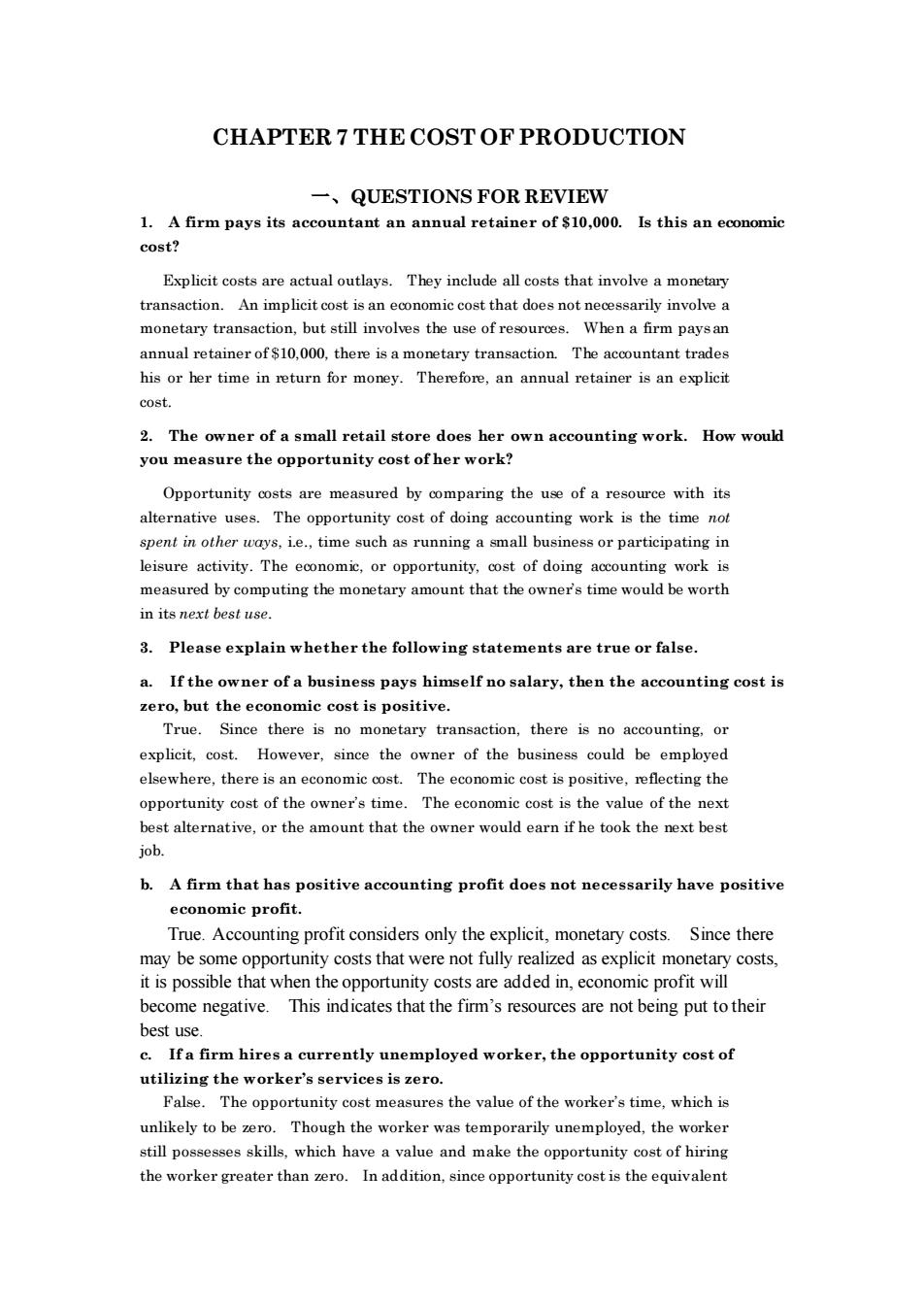正在加载图片...

CHAPTER 7 THE COST OF PRODUCTION QUESTIONS FOR REVIEW 1.A firm pays its accountant an annual retainer of $10,000.Is this an economic cost? Explicit costs are actual outlays.They include all costs that involve a monetary transaction.An implicit cost is an eor mic cost that does not nec ily involve monetary tran When a firm payaa annual retainer of $10.000,there is a monetary transaction.The accountant trades his or her time in return for money.Therefore,an annual retainer is an explicit cost. 2.The owner of a small retail store does her own accounting work.How would you measure the opportunity cost of her work? Opportunity costs are measured by omparing the use of a res with its alternative The opportunity cost of doing accounting work is the time no spent in other uays,i.e.time such as running a small business or participating in leisure activity.The economic,or opportunity,cost of doing accounting work is measured by computing the monetary amount that the owner's time would be worth in its next best use」 3.Please explain whether the following statements are true or false Ifthe owner of a business pays himself no salary,then the accounting co zero,but the eco st is positive True Since there is no monetary transaction,there is no accounting.or explicit,cost. However,since the owner of the business could be empbyed elsewhere,there is an economic cost.The economic cost is positive.reflecting the alte or the amount that the owner would earn if he took the next best job. b.A firm that has positive accounting profit does not necessarily have positive economic profit. True.Accounting profit considers only the explicit.monetary costs.Since there may be some opportunity costs that were not fully realized as explicit monetary costs at w the opportunityc e added in,econor p ofit will become negative.This indicates that the firm's resources are not being put to their best use. c.Ifa firm hires a currently unemployed worker,the opportunity cost of utilizing the worker's services is zero. False.The opportunity cost measures the value of the worker's time.which is unlikely to bez Though the worker was temporarily unemployed,the worker still possesses skills,which have a value and make the opportunity cost of hiring the worker greater than zero.In addition,since opportunity cost is the equivalent CHAPTER 7 THE COST OF PRODUCTION 一、QUESTIONS FOR REVIEW 1. A firm pays its accountant an annual retainer of $10,000. Is this an economic cost? Explicit costs are actual outlays. They include all costs that involve a monetary transaction. An implicit cost is an economic cost that does not necessarily involve a monetary transaction, but still involves the use of resources. When a firm pays an annual retainer of $10,000, there is a monetary transaction. The accountant trades his or her time in return for money. Therefore, an annual retainer is an explicit cost. 2. The owner of a small retail store does her own accounting work. How would you measure the opportunity cost of her work? Opportunity costs are measured by comparing the use of a resource with its alternative uses. The opportunity cost of doing accounting work is the time not spent in other ways, i.e., time such as running a small business or participating in leisure activity. The economic, or opportunity, cost of doing accounting work is measured by computing the monetary amount that the owner’s time would be worth in its next best use. 3. Please explain whether the following statements are true or false. a. If the owner of a business pays himself no salary, then the accounting cost is zero, but the economic cost is positive. True. Since there is no monetary transaction, there is no accounting, or explicit, cost. However, since the owner of the business could be employed elsewhere, there is an economic cost. The economic cost is positive, reflecting the opportunity cost of the owner’s time. The economic cost is the value of the next best alternative, or the amount that the owner would earn if he took the next best job. b. A firm that has positive accounting profit does not necessarily have positive economic profit. True. Accounting profit considers only the explicit, monetary costs. Since there may be some opportunity costs that were not fully realized as explicit monetary costs, it is possible that when the opportunity costs are added in, economic profit will become negative. This indicates that the firm’s resources are not being put to their best use. c. If a firm hires a currently unemployed worker, the opportunity cost of utilizing the worker’s services is zero. False. The opportunity cost measures the value of the worker’s time, which is unlikely to be zero. Though the worker was temporarily unemployed, the worker still possesses skills, which have a value and make the opportunity cost of hiring the worker greater than zero. In addition, since opportunity cost is the equivalent